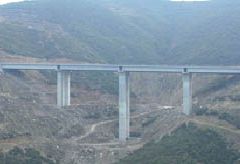The Institute
The Institute of Engineering Seismology & Earthquake Engineering (ITSAK) is a research center established in 1979. It has been operating free field strong motion instruments on a national scale (consisting of more than 96 instruments) and a special 3D strong motion array in the Euro-SeisTest. Moreover, two permanent special arrays on structures are maintained by the staff of ITSAK, those of Evripos cable-stayed bridge and a building at Thessaloniki.
Additionally, ITSAK owns digital accelerographs and three mobile structural array consisting of 16 accelerometers and a 24-bits data acquisition system for the instrumentation of structures (buildings, bridges, dams, etc), which are deployed during aftershock studies or field experiments, portable high resolution seismograph recorders suitable for noise measurements, as well as geophysical and geotechnical field and laboratory instruments. Apart from the experimental infrastructure, a significant computational center and the appropriate know-how, has also been developed in ITSAK. The Laboratory of ITSAK is fully equipped for the maintenance and repair of the above instruments.
ITSAK is one of the few multidisciplinary European research centers. ITSAK scientific staff is divided into three departments with distinct research interests but closely cooperating, structured as following:
- Division of Engineering Seismology: simulation of strong motion, attenuation and empirical modelling of strong motion characteristics, site effects modelling and assessment, probabilistic seismic hazard analysis, seismicity, etc.
- Division of Geotechnical Earthquake Engineering: evaluation of dynamic properties of soils and rocks, specific site response studies, assessment and evaluation of soil non-linearities and topography effects, liquefaction studies, soil-structure interaction effects, seismic design of earth structures, such as: dams, reinforced steep slopes, embankments, etc.
- Division of Earthquake Engineering: analytical and experimental investigation of seismic behaviour of civil engineering structures, such as: bridges, buildings, dams, etc., seismic evaluation of existing structures, vulnerability assessment of the built environment, retrofitting and repairing techniques for structures, energy-related measures of seismic action, seismic behaviour of underground structures.
ITSAK was one of the key Institutes for the compilation of the seismic hazard map of Greece that was included in the Greek Seismic Code. Research in support of several Greek Seismic Code provisions, regarding seismic design of structures and soil dynamic behaviour issues, is also going on.
The results of this research have been published in referee international journals and presented in international congresses.
The scientists of ITSAK have participated and participate in numerous national and European research projects (i.e. EUROSEISTEST, EUROSEISMOD, EUROSEISRISK, HiPER-CRACK, International Site for European Strong Motion Data, SESAME, etc).
ITSAK also hosts at Thessaloniki, the permanent Secretariat of the Association of Seismic protection of the Black-Sea economic coorporation countries (ASP-BSEC), with 11 participating members.
- Integrated monitoring of structures, such as : buildings, bridges, earthfill or rockfill dams, steep slopes and highway embankments (experimental and analytical approach), including free-field and downhole measurements, as well as foundation and superstructure seismic response.
- Seismic risk analysis: combination of seismic hazard analysis, site-specific response analysis and vulnerability analysis, including soil-structure interaction effects.
- Energy based assessment of seismic events damageability



